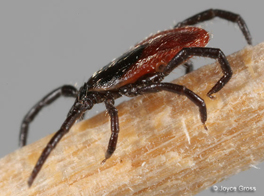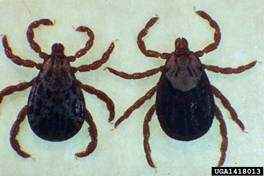Harbingers of Spring
Nature has endowed this little insect with two tick tricks for its protection and longevity. One is the special pad on each of its feet that enables it to propel itself at a constant rate over almost any kind of surface. The other is its 3-mm-long, flat body profile which makes it difficult for larger animals, birds, and humans, to scratch it loose or pull it off.
In the vicinity of Beacon Rock on 5 April 1806, Clark dutifully looked around for signs that spring had begun. He noticed that “the tick has made it’s appearance.” And he observed that it was “the Same with those of the Atlantic States.” He was of course unable to identify the species (of which there are at present 80 in the continental U.S.), just as he would not have known that there were four different species of ticks native to Virginia, the state where he was born.
The annual tick season in the American west is commonly from March to September. Specifically, however, ticks thrive best during the period when the humidity is favorable to their survival. Along the Lewis and Clark Trail in the Rocky Mountains, from Western Montana through central Idaho, it begins with the first hot days following the last of the spring rains, whenever that may be, and ends around mid-July when the hottest, driest mountain weather sets in.
Back on 1 January 1806, Sergent Gass had written that “the ticks, flies and other insects are in abundance, which appears to us very extraordinary at this season of the year, in a latitude so far north.” In the coastal regions of which Fort Clatsop was a part, ticks sometimes do appear during the winter months.[1]Some argue that Gass was mistaken when he wrote that ticks were present at Fort Clatsop in mid-winter. However, this editor once received a tick bite on a warm and wet coastal mid-winter day. Like … Continue reading
The ticks waiting for hosts in the vicinity Beacon Rock in April 1806 were likely of the species Ixodes pacificus (Greek, ICK-so-deez, “sticky” and “of the Pacific”), commonly known as the western blacklegged tick. The distinctions would scarcely have been relevant. Today, in the continental US at large, there are about 80 species in the family Ixodidae (ik-SO-did-eye), or hard ticks.
Vectors for Disease
Wood Tick
Dermacentor andersoni Stiles 1908
Matt Pound, USDA Agricultural Research Services, Bugwood.org
If Clark indeed suffered an attack of Colorado tick fever at the Three Forks of the Missouri in late June of 1805, the guilty vector would most likely have been the species shown here. Of course, he may well have known he was bitten by a tick, but it’s not likely he would have even thought of a connection between the bug and his symptoms. In fact, that link was not discovered for another hundred years.
Ixodes pacificus is a potential vector for lyme disease which, according to the Centers for Disease Control and Prevention, is a bacterium-borne infection producing symptomized by fever, headache, fatigue, and a skin rash. If left untreated, the infection may spread to joints, the heart, and the nervous system.
The tick species that sometimes carries the mild, self-healing Colorado tick fever, or the occasionally fatal Rocky Mountain spotted fever, is the hard-backed tick, Dermacentor andersoni, which was identified in 1908 by entomologist Charles Wardell Stiles (1867-1941) of the U.S. Public Health Service. The specific epithet andersoni acknowledges the tentative discovery by entomologist J. F. Anderson in 1903 that spotted fever of the Rocky Mountains was transmitted by a wood tick. His conclusion was confirmed by Charles Wardell Stiles in 1908. D. andersoni also serves as a mechanical vector for half a dozen other diseases, including the acute viral infection, Colorado tick fever.
Notes
| ↑1 | Some argue that Gass was mistaken when he wrote that ticks were present at Fort Clatsop in mid-winter. However, this editor once received a tick bite on a warm and wet coastal mid-winter day. Like Gass, he was surprised by its timing, but the locals who had lived long in this area were not.—Kristopher Townsend, ed. |
|---|
Experience the Lewis and Clark Trail
The Lewis and Clark Trail Experience—our sister site at lewisandclark.travel—connects the world to people and places on the Lewis and Clark Trail.
Discover More
- The Lewis and Clark Expedition: Day by Day by Gary E. Moulton (University of Nebraska Press, 2018). The story in prose, 14 May 1804–23 September 1806.
- The Lewis and Clark Journals: An American Epic of Discovery (abridged) by Gary E. Moulton (University of Nebraska Press, 2003). Selected journal excerpts, 14 May 1804–23 September 1806.
- The Lewis and Clark Journals. by Gary E. Moulton (University of Nebraska Press, 1983–2001). The complete story in 13 volumes.



